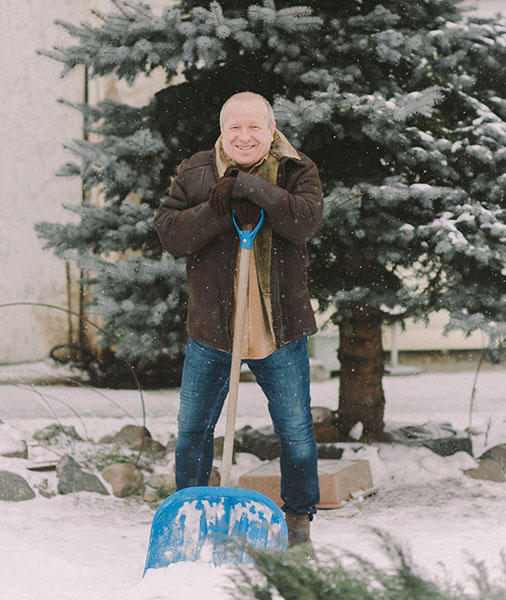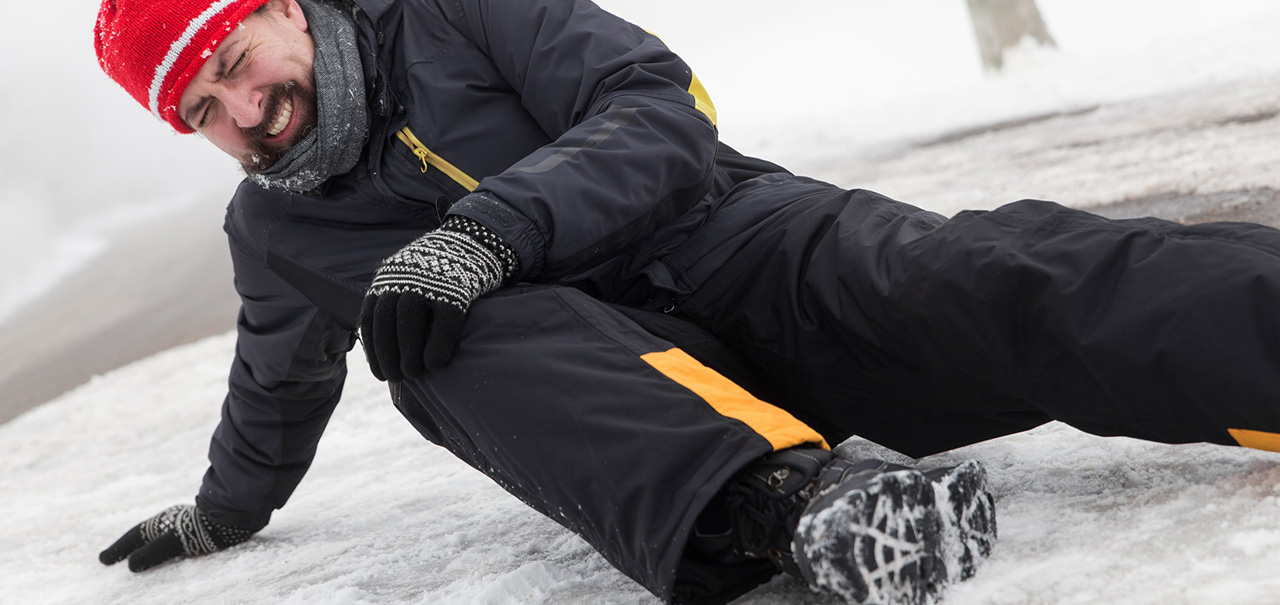How to Prevent Winter Weather Injuries
By Kristy Warren
From shoveling heavy snow to navigating icy sidewalks, winter weather can end in painful injuries. Dr. Steven Heffner from the Laurel Health Centers shares how to avoid dangerous slip-and-falls, sprains, and other common winter injuries as well as ways to prevent re-injury and when to call a professional for help.
HOW TO AVOID SLIPS & FALLS
Your first line of defense in avoiding slips and falls is to cut down on exposure to dangerous winter weather. If you don’t absolutely need to go out in poor weather, skip the trip until the weather improves. Stock up the pantry ahead of bad weather so that you can safely shelter in place during a storm. If you must go out, stick to well-cleared paths sprinkled with rock salt or ice melt.

Wear the right gear. Choose an outdoor shoe or boot with sturdy, rubber soles and a strong, no-slip tread. If you’ll be facing icy surfaces, add slip-on ice cleats to improve your traction.
Dress shoes often have poor tread, so if your job requires them, wear outdoor shoes for your commute and stash your dress shoes in your bag to change into once safely inside.
Take your time and adopt the penguin walk. By slowing down, you’re less likely stumble and slip. Why waddle like a penguin? They are the masters of navigating ice safely! By taking shorter, smaller steps and widening your stance, you reduce your risk of a fall.
Stay alert forchanging weather conditions. A subtle temperature shift can turn a slick surface into hard-to-spot black ice or melt snow into slippery slush. Snowfall can pick up abruptly and create dangerous white-out conditions, and ice can be lurking beneath the piled snow.
Stay handsfree. Keep your hands free when possible to hold onto railings, steady your balance, and catch yourself if starting to slip. Use a backpack, purse, or shoulder bag to carry your belongings and wear gloves to keep your hands warm instead of shoving them into your pockets so you're ready to catch or steady yourself with your hands if needed.

HOW TO SHOVEL SNOW CORRECTLY
Shoveling snow without proper technique and support can damage joints and overwork, sprain, or tear muscles, particularly along your rotator cuff or lower back. It can also put life-threatening stress on your most important muscle: your heart. Shoveling snow can even trigger heart attacks!
Enlist help. If you are ill, a senior, or have a large area to shovel, it is best to enlist the help of loved ones or to hire someone for professional snow removal.
Wear appropriate clothing. You'll be outside for a while—make sure you're protected from the cold with warm clothes designed to stand up to biting outdoor temperatures. Reach for a hat, scarf, heavy winter jacket, water-resistant gloves, and insulated pants, preferably snow pants.

Start gradually. Shoveling snow is vigorous exercise, and as with any workout, it’s important to stretch and warm up. Start slow to warm up your muscles.
Lift with your legs, not your back. Think of snow as lifting a heavy package over and over because heavy snowfall is just that: heavy! Bend at the knees and maintain a straight back when lifting snow. Avoid twisting side-to-side to throw snow over your shoulder.
Take breaks and stay hydrated. Come inside periodically to warm up and rest your muscles. Resting regulates your body temperature and breathing, so a short break helps keep you from overdoing it. Staying hydrated during strenuous activity like shoveling snow is important. If cold water is too unappetizing, try room-temperature water or tea.
WHEN TO SEEK PROFESSIONAL HELP FOR INJURY
Whether you slipped and fell or believe you may have pulled a muscle, it’s important to know when to seek professional help.
- If you are in severe pain, experiencing double vision, or feeling dizzy, you should head to an emergency room.
- If you’re in moderate pain that’s not improving within 24 hours, you should make an appointment with your primary care provider for evaluation. Your provider will assess your condition and recommend the appropriate treatment plan. They may want to image the area to assure there are no fractures or tears, and they may recommend icing, strategic use of moist heat, pain-relieving medications, and exercises depending on the type of injury.
- If you experience changes to your range of motion, flexibility, or trouble with a joint following an injury, you may be referred for chiropractic care or physical therapy to help you safely recover your mobility.
Laurel Health’s chiropractic team offers safe, personalized chiropractic services to patients of all ages, regardless of their ability to pay. Treatment is always customized based on your unique needs and comfort level. Laurel Health’s chiropractic treatments use the region’s most advanced therapies and cutting-edge equipment, featuring both traditional manual adjustments and non-invasive tools.
Dr. Heffner is passionate about ensuring all patients in Bradford and Tioga Counties have access to high-quality chiropractic care.
He was first drawn to chiropractic care after its role in rehabilitating a baseball injury he suffered in his youth. Now, Dr. Heffner has more than 37 years of work rehabilitation and chiropractic care experience to improve mobility issues, chronic pain, and joint health.
He specializes in the McKenzie Method® of Mechanical Diagnosis and Therapy (MDT) and electromyography (EMG) testing to assess the health of muscles and nerves.
Dr. Heffner received his bachelor’s degree from Mansfield University, completed post-graduate studies at Penn State University in State College, PA, and earned his Doctor of Chiropractic degree (DC) from Life Chiropractic College in Marietta, Georgia.

Laurel Health’s chiropractic and family medicine team provides expert care personalized to your needs. If you’ve suffered an injury, don’t wait; call the experts! Dr. Heffner is now seeing patients in Wellsboro, Elkland, and Troy.To make an appointment with Dr. Heffner, call 570-297-3746. To make an appointment with any Laurel Health Center, call 1-833-LAURELHC (1-833-528-7354) and select the location of your choice or click here to view Laurel Health contact numbers by location.
For more winter safety tips, stay tuned to our news page for the latest health and wellness information or follow us on Facebook at facebook.com/laurelhc.
